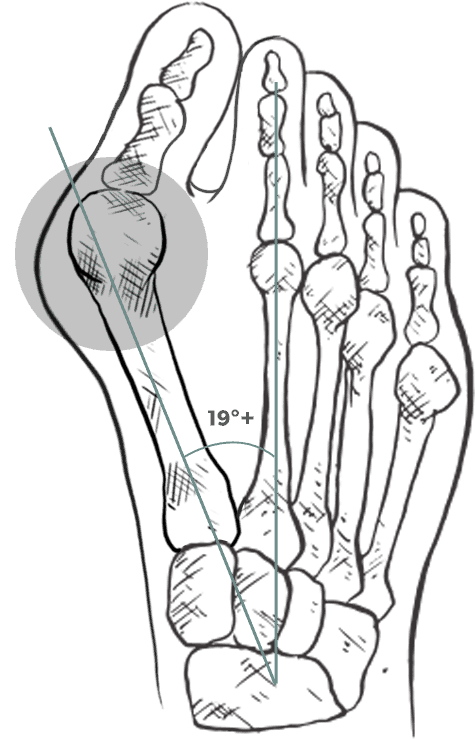Symptoms
Symptoms
What
is a
bunion?
It’s unsightly. It hurts. You can’t really wear the shoes you like. You don’t walk far anymore, never mind exercise. It’s embarrassing because your foot looks unnatural.
You may have a bunion.
There are a lot of misconceptions out there about bunions. The fact is they’re genetic, and manageable.
So what is a bunion? It’s not just a bony bump on the outside of your foot. That’s way too simple. A bunion is a foot abnormality caused by a misalignment within the foot; a misalignment of the first metatarsal bone–the one leading from the middle of your foot to the big toe–or of the first metatarsal cuneiform joint where that bone joins the rest of your foot, or of the big toe joint itself. Or all of the above.
The result is that bony bump you see, which is actually the head of the misaligned first metatarsal bone sticking out to the side, along with a swollen first toe joint and a big toe that may lean toward your second toe, or even overlap it. Bunions involve not just the bones, but ligaments, tendons, cartilage and muscle, too.
If you’re lucky, it’s not painful. But most bunions are. They’re all pretty ugly. And they usually get worse with time.

Are all bunions the same?
In a way, each bunion is unique because every person has a specific set of issues, from bone
structure to ligament laxity to tendon balance. But bunions fall into a few main categories.



Symptoms
Do I have a bunion?
True bunions usually hurt on the side of the big toe joint.
They make it difficult to find shoes that are comfortable (not to mention stylish) and pressure on the big toe joint may make you want to stop exercising, running, or even walking very much.
In addition to pain, from minor to throbbing to sharp, there can be swelling of the joint and a hot, burning sensation. Maybe your big toe is making its way over to your second toe. You may also feel some embarrassment. It’s a type of deformity, after all.
If you have very limited motion in your big toe, say you find it impossible to stand on your tip toes, you may have hallux rigidus, which involves arthritis of the joint, seen on an X-ray.
If your big toe is extremely painful, you don’t feel any relief by taking off your shoes and your toe hurts even when touching the bed sheets, you may have gout.
How bad is mine?
There are three levels of severity for a Hallux Valgus bunion
Your level is determined by a combination of factors including, but not limited to, the degree of misalignment of your first metatarsal bone and the flexibility of your big toe joint. A doctor will take a standing X-ray of your foot and measure the degree of your bone misalignment on a computer. Then he or she will perform a physical exam to check out your joints’ range of motion and flexibility. This consult determines the severity, and ultimately, which treatment option is best for you.
Normal range of motion and stability in the big toe joint. Misalignment between the first and second metatarsal bones is an angle of less than 10 degrees.
Normal range of motion in the big toe joint, and stability in the first metatarsal cuneiform joint. Misalignment between the first and second metatarsal bones is an angle between 10 and 18 degrees.
Normal range of motion in the big toe joint and hypermobility/instability in the metatarsal cuneiform joint in the middle of the foot. Misalignment between the first and second metatarsal bones is an angle greater than 19 degrees.



If you’re in severe pain and have experienced arthritic changes,
you probably have a Hallus Rigidus bunion.
Significantly limited range of motion of the big toe joint (stiff big toe) with or without hypermobility of the metatarsal cuneiform joint. The first and second metatarsal bones may or may not be misaligned. The big toe joint will have some arthritic changes and a hard bump on top of it.

Bunion Fact # 73
It’s nearly impossible to tell how severe your bunion is yourself.
An experienced bunion surgeon uses this exam to figure out the best way to diagnose and correct your specific condition.
Symptoms
What else can happen if I have a bunion?
If you have a bunion, or two, friends may tell you just to live with it, especially if it’s not painful.
In fact, many women build a whole life around their bunions to accommodate them-wearing only super ‘comfortable’ shoes or developing a wardrobe around ‘sneaker style,’ adapting their exercise patterns and getting weekly pedicures. Forget sandals.

Here are some of the complications you may experience, from not such a big deal, to a very big deal.
- Ingrown toenails
- Corns
- Hammertoes
- Pain in the ball of the foot
- Bone spur on the side of toe joint
- Limited choice of footwear
- Difficulty walking normally
- Callouses on the ball of the foot and/or sides of the toes
- Inflamed or infected skin outside of toe joint
- Knee, hip or back problems
- First toe leaning pressing against or crossing under or over second toe
- Ruptured plantar plate (a very important structure that stabilizes your second toe)
- Difficulty exercising, especially weight-bearing
Bunion Fact #58
Bunions do not get better on their own. And they get worse with time. You can easily go from a Mild bunion to Moderate to Severe, and the level of severity ultimately determines the treatment. So there’s a real argument to be made for dealing with the issue early, before it progresses.
